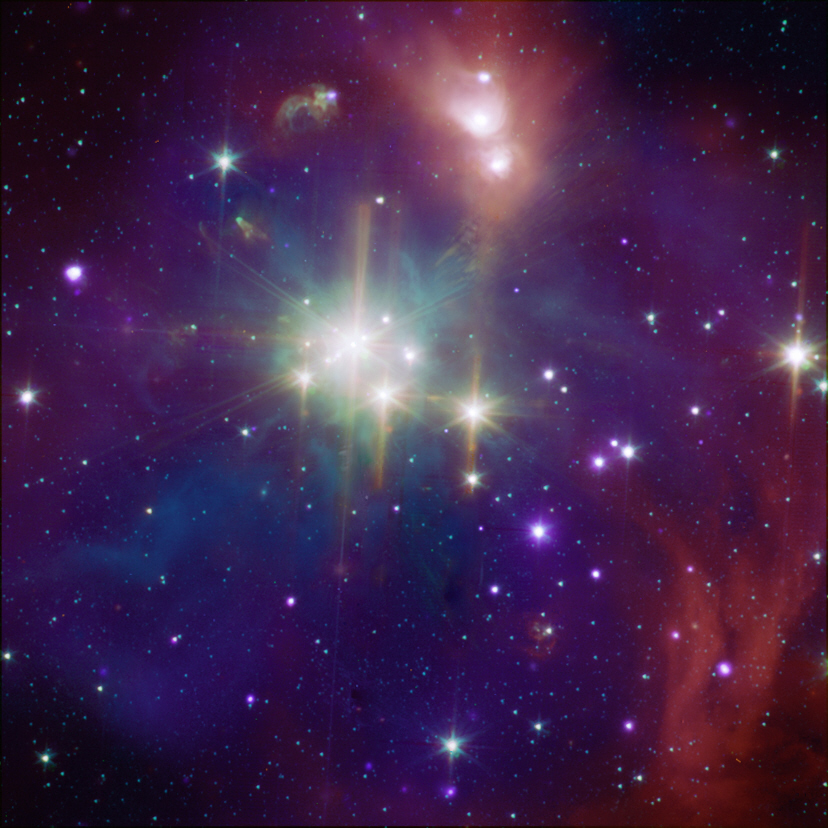Celestial Coronet Cluster
ω
This montage has a dreamy bearing
lending it poetic appeal,
due to mantle of dust it’s wearing
in that astral image surreal.
The multi-wavelength composite wed
Chandra’s x-rays of purple hue
to combine with Spitzer’s infrared
tricolor data in this view,
precisely orange, cyan, and green,
of a soft diaphanous mien,
teasing the senses with lovely scene
bathed in glowing satiny sheen.
Young stars appear with varied ages
bluish in the illustration
thus depicting assorted stages
of their individuation.
This small grouping astronomy shows
a pellucid picture of growth
for studies penned in technical prose,
plus stelliferous lyrics both,
composed by bards of the vast beyond,
like Andrew Marvell in ‘Empire
Music’, those arts with classical bond
to universally inspire.
A passage with evocative phrase,
to wit, ‘mosaic of the air’
could hint of wonderments that amaze
throughout the cosmos everywhere.
Part of Corona Australis scheme,
four hundred twenty light-years far,
resides the region of poem’s theme,
which is forming many a star.
The pattern looks like supernal crown
or diadem sparkling in stars,
for fabled figures with grand renown
of colossal kings, queens, and czars.
It is called the Coronet Cluster,
which could be confused with cornet,
played by Louis Armstrong with luster
in his style one doesn’t forget.
That realm suggests Turner’s use of paints
to convey pure shimmering light,
evanescent, devoid of constraints,
as an impressionistic sight.
Orion’s sphere may more noted be
than its circlet cousin low key,
but this spatial stellar nursery
seems a land where fancy is free.
In dreams of seas lapis lazuli
my spaceship cruises as it might
midst bubble worlds far as eye can see
while I drift to my heart’s delight
amongst lilac and purple hazes,
coming back to the pale blue dot
awash with mindless human crazes
on our delicate mortal spot.
All that exists is impermanent,
I reflect, with gaze at the sky,
including the heavens’ firmament
where even stars are born and die,
unless there’s a deeper dimension
eluding our comprehension…
~ Harley White
* * * * * * * * * *
Inspiration derived from the following sources…
Article and image ~ “Coronet Cluster: A Neighbor of Star Formation”...
APOD image and info ~ Coronet in the Southern Crown...
Image and info ~ Coronet Cluster in X-Ray and Infrared...
The Corona Australis Constellation ~ info and video...
Poem “Musick’s Empire” (stanza v) by Andrew Marvell (1621–1678)...
“Music’s Empire” by Andrew Marvell ~ spelling modernized...
English artist J. M. W. Turner a.k.a., William Turner (1775–1851) ~ paintings of later years...
Further inspiration derived from the teachings and writings of Nichiren Daishōnin…
Nam Myōhō Renge Kyō means to devote our lives to and found them on (Nam[u]) the Utterness of the Dharma (Myōhō) [entirety of existence, enlightenment and unenlightenment] permeated by the underlying white lotus flower-like mechanism of the interdependence of cause, concomitancy and effect (Renge) in its whereabouts of the ten [psychological] realms of dharmas [which is every possible psychological wavelength] (Kyō).
The reason that we continually recite Nam Myōhō Renge Kyō
Image explanation ~ This composite image shows the Coronet cluster in X-rays from Chandra (purple) and infrared from Spitzer (orange, green, and cyan). The Spitzer image shows young stars plus diffuse emission from dust.

Credit: X-ray: X-ray: NASA/CXC/CfA/J.Forbrich et al.; Infrared: NASA/SSC/CfA/IRAC GTO Team
| Table of Contents |
|